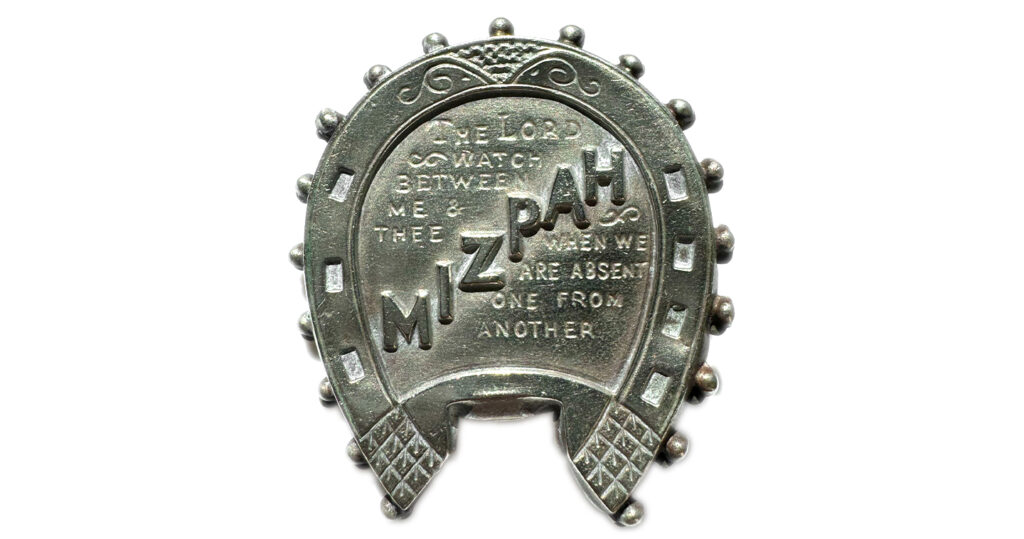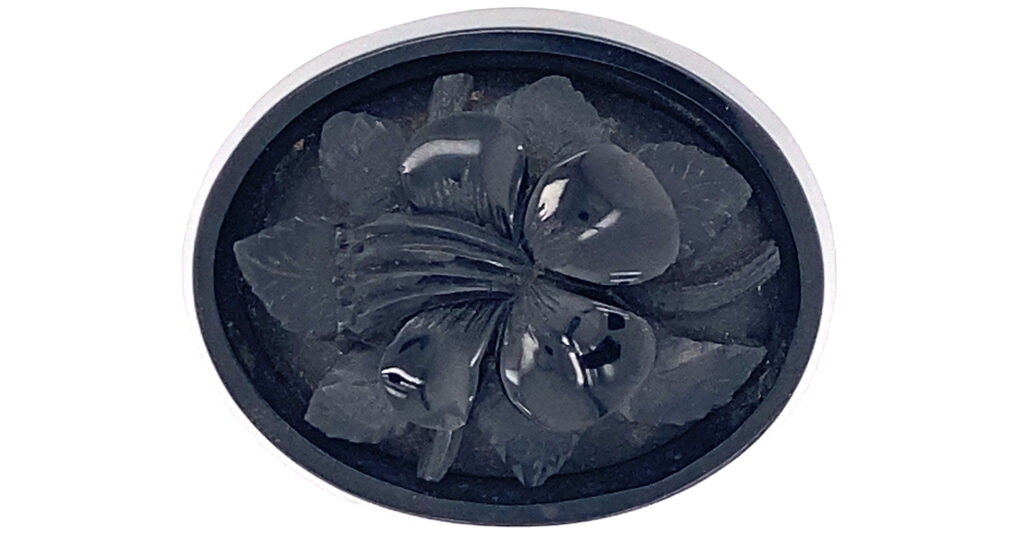Peacock Symbolism in a Neoclassical Brooch
For a work of art from a specific period in jewellery history, there’s nothing so unique as this brooch. Forsaking the common painting of sepia or watercolour, this piece is created in three dimensions with seed pearls and gold, creating a symbolic portrayal out of materials.
Surrounded with paste, it shows a peacock sitting atop an unbroken column, but is unfortunately unsigned or dedicated. Created on a blue background, it signifies the consideration that the loved one was royalty. Simply an extraordinary piece to consider when studying neoclassical jewellery.
The peacock is such a strong motif among so many cultures. Let’s begin with the Greek perception of the bird. Originally, the peacock was associated with the goddess Hera (or Juno), who placed the hundred eyes upon the plumage representing eyes of Argus as guardian of Io (one of Zeus’ lovers), whom Her punished – also they show the vault of heaven, with the eyes of the stars above.
We’ll move into the depiction of the bird in jewellery later in the article, but let’s focus for a second on its natural depiction. The bird has the magnificent plumage with the apparent ‘eyes’ that develop when the bird raises these feathers. Since the bird has been recorded in history, this has captured the imagination of society; cultures have attempted to understand and define these feathers within the greater symbolic understanding of their own lexicon. From a jewellery perspective, they’re simply beautiful, but to understand why the bird is so popular, we need to take a look at these cultural representations.
I don’t often like to stray too far from the Western symbolism and its representations, as they can cloud the meaning of the symbol within early modern jewellery, but the Babylonian and Persian representations of the symbol are for the guardian of loyalty and often used to represent royalty. In Hindu culture, Lakshimi is associated with the peacock (depicted blue), linked with patience, kindness, compassion, benevolence and good luck. Asian representations involve Quan Yin and the association as a signifier of love, compassionate watchfulness, goodness and nurturing. Essentially, Kuan Yin (Quan Yin) is shown with a peacock to show her as a protector of all creatures. As often with deity associations, the symbolism of the animal becomes the symbolism of the deity and vice versa.
And where do we go from here? Most of the interpretations of the peacock will relate to our study on jewellery, as once we start to take in the modern interpretations, we have to understand them before we can recognise them in a jewel or as a symbol for the self.
“Cauda pavonis” was the moment in alchemy when the purification of metal would transmute the mercury into gold; the purification of metals where the hermetic tradition understood that inside each metal, a golden soul was awaiting the moment to emerge. This moment was thought to take millions of years, however, alchemists believed they commanded a system of evolving the metals by burning the impurities of the lead. Transformation into a golden purity.
And what does “cauda pavonis” translate to? Why, “peacock’s tail”, of course! This also related to the moment of understanding that the human soul would comprehend, when at the point of rebirth, the soul would see no difference between the person and nature – all was linked. At this point, as with the impurity of the lead being burnt away, the soul would become a soul of gold.
There we have the perception of the peacock in a time when memento mori was becoming a statement of living, a concept that would be presented on the self as a series of symbols to denote mortality and judgement. So, when the peacock is used in jewellery symbolism a century later, were these perceptions kept?
We have to consider the Western, Christian connotations in all things when it comes to memorial and sentimental jewels. Recently I was asked about the greater scope of symbolism in the jewels, but the mindset of society is intrinsically linked with the Christian religion, regardless of how dissociative it tried to become through different art periods.
Saint Augustine wrote of the peacock’s antiseptic qualities and incorruptibility, based upon the perceptions of the bird’s flesh not decaying and the association with the bird in Christ’s resurrection. Bringing this back, as most symbols do, to the natural world; the belief was that the bird loses its feathers in the autumn and grows them in the spring. Once again, seasonal resurrection, much as the harvest of wheat (fertility) and all other naturally occurring symbols. From this, we’re leading into the associations of the peacock in jewellery that we can identify. When we see the peacock, we need to understand what the person who was commissioning or wearing these pieces were considering when using them to represent themselves. Firstly, we must think sentimentality and memorials, then we must consider why that would be worn.
Moving back to the natural, the perception of the all-seeing church is defined through the naturally occurring ‘eye’ motifs in the plumage of the bird. Reflecting this with Christ’s resurrection and that of the alchemical purity, we have the same concepts occur again, the peacock becomes a modern phoenix; renewing and remaining immortal.
That’s what it boils down to (excuse the pun); incorruptibility of flesh, immortality and integrity.
It’s a Sunday and you’re no doubt growing impatient over this discussion, so I’ll answer the question ‘where do I find the peacock in jewellery?’
That’s not too hard. The piece above shows a connection of symbols (which, if you ask nicely, I’ll discuss in another article) from the late 18th century, a time when the Neoclassical style overcame popular art, culture and society. From this, we have the same Christian connotations, but with the overt nature of them being pushed behind in favour of alluding to the nature of the symbol through the symbol. Here, the peacock was used a symbol in conjunction with others to denote the above – incorruptibility of flesh, immortality and integrity. You can find it in bracelets, rings, pendants and other peripheral jewellery painted on ivory. From the 19th century, you can find the symbol standing on its own, often encrusted with jewels and given as a token of love/affection for the same symbolic reasons.
By the 20th century, the peacock became part of the decorative lexicon of the Art Deco movement, influenced by the paradigm sift in the late 19th century to using natural designs in jewellery. This came as a shift away from the 19th century revival periods and the many years of stylistic stagnation that individual designers broke free from (hence the rise of Art Nouveau), so in many ways, the peacock had found its presentation in jewellery for its own plumage, rather than be relegated to its symbolic nature. The Pre-Raphaelites understood the past and broke free from its paradigms by re-interpreting style, a kind of revival in itself, but presenting a solid statement against the mainstream style that had kept the late 19th century in a very formal paradigm. Finding a peacock motif (peacock eye, colours of the plumage, symbol entwined in a design) would not be uncommon and mostly set in silver.
One cannot forget the colour of the bird; its colours are important for the materials used to represent them. Opal, foil backed glass, sapphire, topaz and aquamarine would be used to represent the plumage. This was not a rule, as the motif often overrode the natural beauty of the bird and it became the shape of the bird to be the primary symbol (which could be filled with any other coloured stone).








